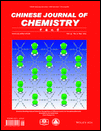Preparation and Intramolecular CC Coupling Reaction for Bis-benzimidazolium Salt
Rui Liu
Tianjin Key Laboratory of Structure and Performance for Functional Molecules, Key Laboratory of Inorganic-Organic Hybrid Funtional Material Chemistry, Ministry of Education, College of Chemistry, Tianjin Normal University, Tianjin 300387, China
Search for more papers by this authorRan Huo
Tianjin Key Laboratory of Structure and Performance for Functional Molecules, Key Laboratory of Inorganic-Organic Hybrid Funtional Material Chemistry, Ministry of Education, College of Chemistry, Tianjin Normal University, Tianjin 300387, China
Search for more papers by this authorYue Bi
Tianjin Key Laboratory of Structure and Performance for Functional Molecules, Key Laboratory of Inorganic-Organic Hybrid Funtional Material Chemistry, Ministry of Education, College of Chemistry, Tianjin Normal University, Tianjin 300387, China
Search for more papers by this authorZhixiang Zhao
Tianjin Key Laboratory of Structure and Performance for Functional Molecules, Key Laboratory of Inorganic-Organic Hybrid Funtional Material Chemistry, Ministry of Education, College of Chemistry, Tianjin Normal University, Tianjin 300387, China
Search for more papers by this authorCorresponding Author
Qingxiang Liu
Tianjin Key Laboratory of Structure and Performance for Functional Molecules, Key Laboratory of Inorganic-Organic Hybrid Funtional Material Chemistry, Ministry of Education, College of Chemistry, Tianjin Normal University, Tianjin 300387, China
Tianjin Key Laboratory of Structure and Performance for Functional Molecules, Key Laboratory of Inorganic-Organic Hybrid Funtional Material Chemistry, Ministry of Education, College of Chemistry, Tianjin Normal University, Tianjin 300387, ChinaSearch for more papers by this authorRui Liu
Tianjin Key Laboratory of Structure and Performance for Functional Molecules, Key Laboratory of Inorganic-Organic Hybrid Funtional Material Chemistry, Ministry of Education, College of Chemistry, Tianjin Normal University, Tianjin 300387, China
Search for more papers by this authorRan Huo
Tianjin Key Laboratory of Structure and Performance for Functional Molecules, Key Laboratory of Inorganic-Organic Hybrid Funtional Material Chemistry, Ministry of Education, College of Chemistry, Tianjin Normal University, Tianjin 300387, China
Search for more papers by this authorYue Bi
Tianjin Key Laboratory of Structure and Performance for Functional Molecules, Key Laboratory of Inorganic-Organic Hybrid Funtional Material Chemistry, Ministry of Education, College of Chemistry, Tianjin Normal University, Tianjin 300387, China
Search for more papers by this authorZhixiang Zhao
Tianjin Key Laboratory of Structure and Performance for Functional Molecules, Key Laboratory of Inorganic-Organic Hybrid Funtional Material Chemistry, Ministry of Education, College of Chemistry, Tianjin Normal University, Tianjin 300387, China
Search for more papers by this authorCorresponding Author
Qingxiang Liu
Tianjin Key Laboratory of Structure and Performance for Functional Molecules, Key Laboratory of Inorganic-Organic Hybrid Funtional Material Chemistry, Ministry of Education, College of Chemistry, Tianjin Normal University, Tianjin 300387, China
Tianjin Key Laboratory of Structure and Performance for Functional Molecules, Key Laboratory of Inorganic-Organic Hybrid Funtional Material Chemistry, Ministry of Education, College of Chemistry, Tianjin Normal University, Tianjin 300387, ChinaSearch for more papers by this authorAbstract
Bis-benzimidazolium salt 1 was prepared via a series of reactions using 2,2′-diphenol as starting material. Compound 2 was afforded through the intramolecular CC coupling reaction of 1 under the catalysis of Pd(OAc)2. The structure of 2 is characterized through X-ray diffraction analyses, 1H NMR and 13C NMR. In 2, two boat-like seven-membered rings are contained, where the CC bond distance newly formed is 1.461(5) Å, and it is between regular CC single bond (1.54 Å) and CC double bond (1.34 Å). This shows that new CC bond has partial double-bond character. In the crystal packing of 2, the 2D supramolecular layers are formed via CH···F hydrogen bond.
REFERENCES
- 1 Glasbeek, M.; Zhang, H.. Chem. Rev., 2004, 104, 1929.
- 2a Plechkova, N. V.; Seddon, K. R.. Chem. Soc. Rev., 2008, 37, 123.
- 2b Dupont, J.. Acc. Chem. Res., 2011, 44, 1223.
- 3 Wang, J. H.; Feng, H. T.; Luo, J.; Zheng, Y. S.. J. Org. Chem., 2014, 79, 5746.
- 4 Goodenough, J. B.; Kim, Y.. Chem. Mater., 2010, 22, 587.
- 5 Choi, H.; Baik, C.; Kang, S. O.; Ko, J.; Kang, M. S.; Nazeeruddin, M. K.; Grätzel, M.. Angew. Chem., 2008, 120, 333.
- 6a Hahn, F. E.; Jahnke, M. C.. Angew. Chem., 2008, 120, 3166.
- 6b Zhang, R.; Wang, D.; Xu, Q.; Jiang, J. J.; Shi, M.. Chin. J. Chem., 2012, 30, 1295.
- 6c Benhamou, L.; Chardon, E.; Lavigne, G.; Bellemin-Laponnaz, S.; César, V.. Chem. Rev., 2011, 111, 2705.
- 7a McCartney, D.; Guiry, P. J.. Chem. Soc. Rev., 2011, 40, 5122.
- 7b Liu, Q. X.; Zhang, W.; Zhao, X. J.; Zhao, Z. X.. Eur. J. Org. Chem., 2013, 7, 1253.
- 7c Chai, H. X.; Li, J. R.; Yang, L. P.; Liu, M. X.; Yang, D. L.; Zhang, Q.; Shi, D. X.. Chin. J. Chem., 2014, 32, 865.
- 8a Agrofoglio, L. A.; Gillaizeau, I.; Saito, Y.. Chem. Rev., 2003, 103, 1875.
- 8b Churruca, F.; SanMartin, R.; Inés, B.; Tellitu, I.; Domínguez, E.. Adv. Synth. Catal., 2006, 348, 1836.
- 9a Knowles, J. P.; Whiting, A.. Org. Biomol. Chem., 2007, 5, 31.
- 9b Ahrens, S.; Zeller, A.; Taige, M.; Strassner, T.. Organometallics, 2006, 25, 5409.
- 9c Zhang, W. X.; Zhang, X. Q.; Luo, M. M.. Chin. J. Chem., 2012, 30, 1423.
- 10 Madison, W. I., SAINT Software Reference Manual, Bruker AXS, Madison, WI, 1998.
- 11 Sheldrick, G. M., SHELXTL NT (Version 5.1), Program for Solution and Refinement of Crystal Structures, University of Göttingen, Göttingen (Germany), 1997.
- 12 Palmer, D. C.. Crystal Maker 7.1.5, CrystalMaker Software, Yarnton, UK, 2006.
- 13 Arnold, P. L.; Casely, I. J.. Chem. Rev., 2009, 109, 3599.
- 14 Liu, Q. X.; Yang, X. Q.; Zhao, X. J.; Ge, S. S.; Liu, S. W.; Zang, Y.; Song, H. B.; Guo, J. H.; Wang, X. G.. CrystEngComm, 2010, 12, 2245.




